|
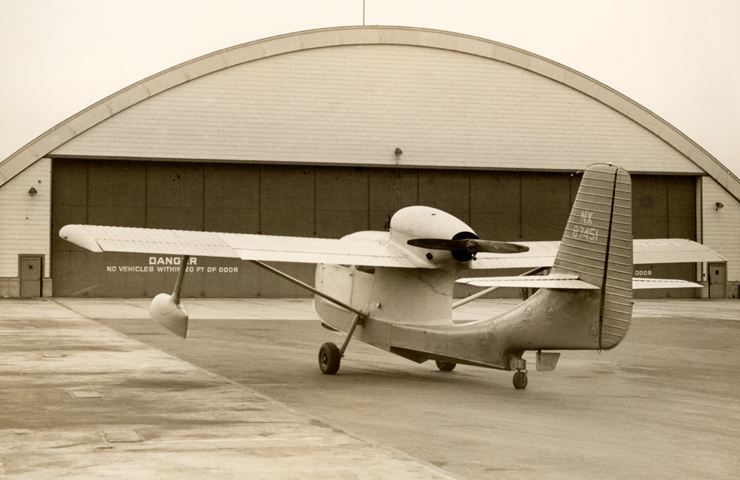
Republic RC-3 Seabee prototype NX87451
December 1945
New four-place all-metal amphibian personal or family plane with exceptional roominess, sturdiness, and wide range of practical utility for business or pleasure. Has a high speed of 120 miles per hour and a cruising speed of 103 miles per hour, with a range of 560 miles on 75 gallons of fuel. Powered by a Franklin Aircooled engine of 215 horsepower, the Seabee carries four adults and baggage in comfort, and operates with equal ease off either land or water. Wing span is 37 feet 8 inches and the overall length 27 feet 10¾ inches. Standard equipment includes two-way radio, electric starter, hydraulically operated flaps, dual wheel controls, retractable landing gear, full component of
C.A.A. basic flight and engine instruments, and features low, wide doors on both sides and a roomy nose door in the bow for fishing, anchoring or docking. Rearward mounted engine and pusher type propeller accentuate exceptional visibility. Take off run 800 ft. from land and 1,000 ft. from water; landing run 400 ft. on land and 700 ft. on water. Simplified design features increase plane’s ruggedness, safety, durability and usefulness, yet reduce manufacturing costs to enable Republic to produce Seabees at $4495, retail price.
RAC Press release 1946
|
|
|
|
"EXPERIMENT AT REPUBLIC"
|
"Fortune" Magazine
Article; "Experiment at Republic"
February 1947
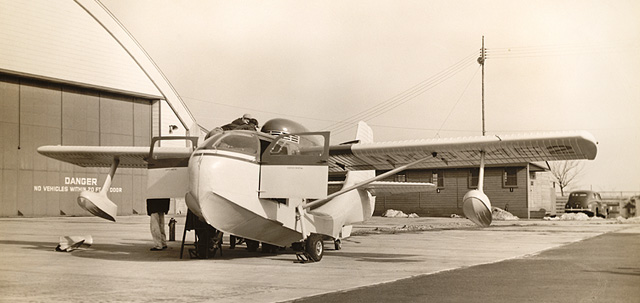
Since V-J day the Republic Aviation Corp. of Farmingdale, Long Island, maker of the famed
P-47 Thunderbolt, has been demonstrating the fact that a military-aircraft manufacturer has plenty of difficulties becoming something else. Specifically, Republic has attempted to
transform itself from a specialist in one aviation field to a specialist in four aviation fields: small private planes, small aircraft
engines, high-speed commercial transports, and high-speed military aircraft. By the end of last year it was apparent that this attempted transformation had been rough on both Republic and its executives. At the same time a large
part of the demonstration has been extremely instructive for both Republic and the aircraft industry.
It has been particularly instructive for Republic's two top men-President Alfred Marchev, a sales and
production-minded newcomer to aviation, and chief engineer Alexander Kartveli, an outstanding U.S. designer of high-speed aircraft. Engineer Kartveli has learned, for example, that it is possible to build a P-47 fin so cheaply and simply that, had it been ready for use on Republic's Thunderbolts during the war, it might have saved the Army more than $2 million. And President Marchev has learned, among other things, that some of his assumptions about the aircraft industry may not be' entirely correct.
Under President Marchev, Republic has made the popular assumption that the day of mass-produced
aircraft is already here, and astonishingly enough it is attempting to prove that the private-aircraft market is now ready to be exploited in the same way the automobile market was exploited forty years ago. On this thesis Republic has staked three years and several mil-lion dollars in an attempt to become the first mass producer of private aircraft. It started out with the belief that a
four-passenger, all-metal, 100-mph amphibian could be so efficiently mass-produced as to sell for the improbable price of $3,995. Since at that price Republic's little
Seabee would cost but one-third of what any orthodox manufacturer would be likely to charge for such a plane, Republic received more than 5,000 orders for it. Since last July, however, the company has hedged its bet by raising its
Seabee price to $6,000 with the explanation that this increase was caused by rising prices, design changes, and
tooling delays. Whatever the reasons for it, a price rise of $2,000 is
an unfortunate setback in any attempt to develop a mass market.
Concurrently with its Seabee experiment, Republic in 1945 moved into the aircraft-engine business by buying Aircooled Motors, Inc., of Syracuse outright for $1,500,000, and
advancing $740,000 for research against future orders for
Seabee engines. Republic expected this investment to be paid for by the savings of more than $300 that Aircooled has effected in the cost of the
Seabee engine. Meanwhile, engine-development costs for Republic were expected to leave a $500,000 deficit for Aircooled on its 1946 sales of some $3 million.
On top of this Republic has undertaken to produce a $1,225,000 transport, whose top speed of 450 mph will make it the world's fastest airliner. During 1946, Republic accepted
$28 million worth of orders for its Rainbow transport, and is pro-posing to begin delivery late this year. By last December, how-ever, Republic still needed at least nine more orders to break even on its Rainbow venture.
In the light of all these uncertainties Republic could be very thankful for the fact that it was a specialist, and a
successful one, in the design and manufacture of military aircraft. In five war years Republic had grown up to be a major
producer by selling the government 15,329 Thunderbolts for a total of $905 million, on which it cleared $11 million. Even for the last war year of 1945, Republic's sales of $222 million were somewhat more than half those of Lockheed, nearly a third those of Douglas, and more than one-third those of Boeing. The corporation ended 1946 with a solid backlog of $70 million in military orders. Some $60 million of this was an order for "more than 500" P-84 Thunderjets, the 611-mph successors to Republic's 500-mph Thunderbolts. Republic was also working on a $12,500,000 contract for two four-engine, high-speed (462 mph), high-altitude (40,000 feet), experimental
photoreconnaissance planes. In addition there were orders for experimental aircraft and missiles, which could one day become important. And if Congress gives the Air Forces the billion or so dollars it is asking for, Republic on its past record will probably get its share. The military business is definitely
good.
However, the first impact of peace struck Republic hard. For 1946, sales were not expected to be more than $27 million -12 per cent of the 1945 figure. An $11-million contract for converting fifty Army
C-54's into transports for American Air-lines last year helped a lot, but the company was anticipating a deficit of $650,000 for 1946-the first it had
suffered since 1939. So little money was coming in by last December, and so much was going out on tools, inventory, promotion, and other expansion-$400,000 a week in payrolls
alone -that company had to get a $5,700,000 bank loan. Republic was in no danger of ending up where it started in 1939 but things looked far different from what they had at the year's beginning.
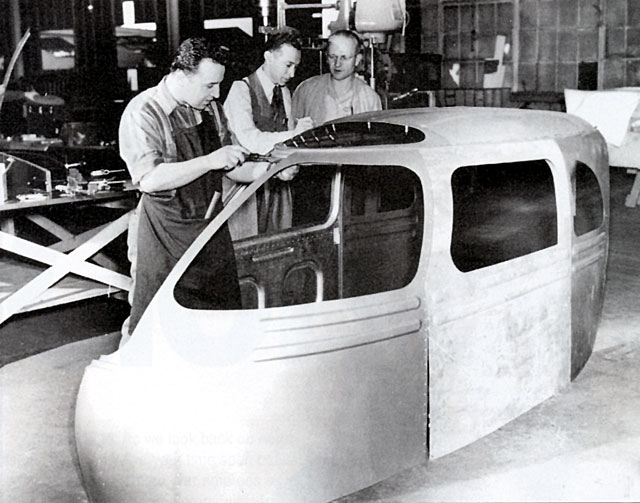
Prophet and angels
Republic struggled to succeed as an aircraft producer for more than ten chaotic years. Born in 1931, the depression child of that imaginative air prophet, Alexander P. de Seversky, Re-public limped along for nine years as the
Seversky Aircraft Corp., while Seversky wooed the Army with publicity stunts. Seversky
set speed records in his experimental fighters and then taught aviatrix Jacqueline Cochran to fly them so she could set women's records. In all the
prewar years, however. Seversky's promotion schemes sold only about 140 planes, of which only seventy-eight went to the poverty-ridden air corps, and inept management piled up heavy deficits each succeeding year,
running to over $1 million in 1937. As it later appeared, the company's chief asset was a brilliant young aircraft designer named Alexander Kartveli, who had joined up with his compatriot
Seversky in 1934.
Throughout the thirties Seversky Aircraft was kept alive by the generosity of a wealthy New York investor and aviation enthusiast, Paul Moore, who poured over $4 million into the company. By 1939, Moore had had enough and that year, with the help of Wall Street's White, Weld
& Co., Seversky Aircraft became the Republic Aviation Corp., supported by a $982,000 common-stock issue. For his $880,000 in notes angel Moore was persuaded to accept $110,000 in cash. (Today, with a 17 per cent interest, he is Republic's biggest stockholder.) When Wallace Kellett, head of a Philadelphia autogiro firm, was
imported to replace
Seversky as President, Seversky promptly sued Republic for $22 million, subsequently settling for "travel
expenses" amounting to less than $80,000. Thereafter, as the
author of the best-selling Victory Through Air Power, which was later made into a Disney movie,
Seversky probably had more influence on U.S. aviation thinking than he had ever had as a plane maker.
The substitution of Kellett for Seversky resulted in peace in the higher echelons at Farmingdale, and another much-needed angel appeared: Lloyd Brace, Vice President of Boston's First National Bank, who got his bank to put up a $1,600,000 loan. And shortly thereafter-in June, 1940-the Air Forces adopted Republic's new Thunderbolt. That should have been Republic's brightest moment. It wasn't, simply because Republic was still almost devoid of aircraft production specialists, as the Air Forces was not long in finding out.
Imported brains
It required the personal pressure of Undersecretary of War Patterson to secure the man the Air Forces wanted for Republic. Ralph Damon was not only a former Army flyer: he had spent some fourteen years as a production man for Curtiss-Wright be-fore becoming an operational Vice President of American Air-lines. He took over Republic's presidency from Mr. Kellett (who became Board Chairman) in May, 1941, one day before the first Thunderbolt was completed for the Air Forces. By the time he left Republic twenty-eight months later, the plant at
Farming-dale and another at Evansville, Indiana, were turning out a total of 450 Thunderbolts a month.
Remarkable as it was, the performance of Republic under Damon was no guarantee that production levels would stay up after he returned to American Airlines. In February, 1942, however,
Damon had found production-minded Alfred Marchev. Damon in a hurry to find someone to relieve him, met Marchev twice socially, interviewed him once, and hired him. Marchev's career, since his arrival from Switzerland in 1919, had included a brief, early turn with the old Thomas Morse Aircraft Carp. (where
Damon once couldn't get a job), the bankruptcy of his own radio company in the twenties, and various production
engineering jobs with Western Electric, Ithaca Gun Works, Ditto, Inc., and
Signode Steel Strapping Co. Starting as Damon's assistant, Marchev was eventually managing the production of both Republic plants. When
Damon stepped out in September, 1943, Marchev moved smoothly in as Republic's fourth
President. It was the first nonviolent administrative shift in the company's history. At long last, Republic's stockholders could assume that their company had achieved the maturity of
management stability. It was also healthy enough that year to pay a 25-cent common-stock dividend-the first in its history. And, as Republic's new President was well aware, the principal asset Re-public possessed was still the man who had become Republic's chief engineer: Designer
Kartveli.
The perfectionist
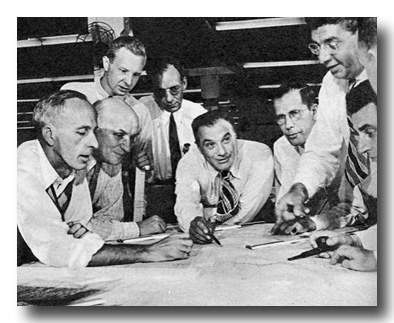 Since military orders are Republic's bread and butter, it is not difficult to understand why chief engineer Alexander Kartveli is Republic's indispensable man. Kartveli's designing genius has made him the outstanding engineer in high-speed air-craft today. His worship of speed is intense, perfectionist, and uncompromising. In his office, for example, there hangs a
picture of Republic's P-47J-but he will not suffer the pain of looking at the final Thunderbolt model Republic eventually produced for the Army-the P-47N. For Kartveli the P-47N fell from grace when the Army insisted on installing a bubble cockpit canopy that violated the perfectly streamlined contours
of his earlier models. This temperamental Russian has remained the darling of the Army-he has successively designed the first
400-mph and the first 500-mph U.S.planes (both Thunder-bolt models), the 462-mph phcto-reconnaissance XF-12, and the P-84 Thunderjet, which last year in Army tests set the official
U.S. speed record at 611 mph. And before these planes Kartveli in 1939 designed the P-43, which was the first plane his former boss
Seversky succeeded in selling in any quantity to the Army. Kartveli, however, is a very expensive
sine qua non. Not because of his $30,000 salary but because his philosophy of high-speed aircraft design is something only the U.S. Air Forces can afford. That philosophy has committed Republic to making the fastest and most painstakingly clean aircraft Kartveli can devise-and to hell with the costs when national security is at stake. It means that Republic today has to have a swarm of 1.100 aeronautical engineers to
worry over the countless
complexities involved in building its racing fighters and transports. Designed for speed and range, equipped and built to customer specifications, the XF-12 and the Rainbow are as handmade as a house
by Frank Lloyd
Wright. The costs of this craftsmanship are enormous. Thus, while the Rainbow superficially appears to be the image of the XF-12 lengthened by a mere five feet, their differences are so complex and numerous that development and production costs for the first Rainbow will be $7,500,000-only 10 per cent less than what has already been spent to build one
XF-12. For the XF-12 the Air Forces pays the full cost price - plus a fixed fee, in this case $240,000 net. Republic's airline clients, however, will be doing exceptionally well if they can afford to pay $1,225,000 apiece for their Rainbows, with a possible profit of 10 per cent for Republic after the thirty-five break-even point has been reached. In the competitive private-aircraft market Kartveli's talents are obviously uneconomic. But those talents, having
produced $11 million in Thunderbolt profits in five war years, are
largely responsible for Republic's current $70-million backlog of military aircraft, which can easily turn into a $7 to $8-million
profit upon the completion of the contracts.
Since military orders are Republic's bread and butter, it is not difficult to understand why chief engineer Alexander Kartveli is Republic's indispensable man. Kartveli's designing genius has made him the outstanding engineer in high-speed air-craft today. His worship of speed is intense, perfectionist, and uncompromising. In his office, for example, there hangs a
picture of Republic's P-47J-but he will not suffer the pain of looking at the final Thunderbolt model Republic eventually produced for the Army-the P-47N. For Kartveli the P-47N fell from grace when the Army insisted on installing a bubble cockpit canopy that violated the perfectly streamlined contours
of his earlier models. This temperamental Russian has remained the darling of the Army-he has successively designed the first
400-mph and the first 500-mph U.S.planes (both Thunder-bolt models), the 462-mph phcto-reconnaissance XF-12, and the P-84 Thunderjet, which last year in Army tests set the official
U.S. speed record at 611 mph. And before these planes Kartveli in 1939 designed the P-43, which was the first plane his former boss
Seversky succeeded in selling in any quantity to the Army. Kartveli, however, is a very expensive
sine qua non. Not because of his $30,000 salary but because his philosophy of high-speed aircraft design is something only the U.S. Air Forces can afford. That philosophy has committed Republic to making the fastest and most painstakingly clean aircraft Kartveli can devise-and to hell with the costs when national security is at stake. It means that Republic today has to have a swarm of 1.100 aeronautical engineers to
worry over the countless
complexities involved in building its racing fighters and transports. Designed for speed and range, equipped and built to customer specifications, the XF-12 and the Rainbow are as handmade as a house
by Frank Lloyd
Wright. The costs of this craftsmanship are enormous. Thus, while the Rainbow superficially appears to be the image of the XF-12 lengthened by a mere five feet, their differences are so complex and numerous that development and production costs for the first Rainbow will be $7,500,000-only 10 per cent less than what has already been spent to build one
XF-12. For the XF-12 the Air Forces pays the full cost price - plus a fixed fee, in this case $240,000 net. Republic's airline clients, however, will be doing exceptionally well if they can afford to pay $1,225,000 apiece for their Rainbows, with a possible profit of 10 per cent for Republic after the thirty-five break-even point has been reached. In the competitive private-aircraft market Kartveli's talents are obviously uneconomic. But those talents, having
produced $11 million in Thunderbolt profits in five war years, are
largely responsible for Republic's current $70-million backlog of military aircraft, which can easily turn into a $7 to $8-million
profit upon the completion of the contracts.
The heretic
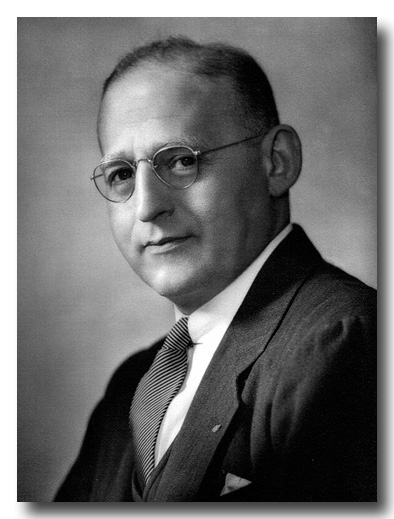 The other man in Republic's life is a tough-minded Swiss production enthusiast and salesman extraordinary, who is the
antithesis of Kartveli, the engineering perfectionist. President Marchev's
efficient, cost-conscious approach to aircraft manufacture is that of a crusading apostle of Detroit's production methods. Factually, of course, he is neither an automotive nor a peacetime aviation man. Nevertheless, during the war he did an excellent job of keeping Kartveli's Thunderbolt coming off the line. All day long he moves about Republic's shops and offices with the tireless bounce of a wrestler, checking this, re-checking that. In his zeal for following up the work of his subordinates he carries around a stack of three-by-five-inch slips on which he is constantly jotting down memoranda to be filed for later reference, or to be impaled on his desk pen as a current reminder. It is his energy
that charges Republic today. And his enthusiasm for production, matching Kartveli's love for design, was largely responsible for the fact that Republic during the war maintained one of the most consistently reliable performance records in the industry. The glory at Republic may go all to Kartveli, but Marchev's unorthodox ideas about mass-produced aircraft, as demonstrated in the
Seabee, have resulted in the most spectacular economies to be found anywhere in the
U.S. aircraft industry today.
The other man in Republic's life is a tough-minded Swiss production enthusiast and salesman extraordinary, who is the
antithesis of Kartveli, the engineering perfectionist. President Marchev's
efficient, cost-conscious approach to aircraft manufacture is that of a crusading apostle of Detroit's production methods. Factually, of course, he is neither an automotive nor a peacetime aviation man. Nevertheless, during the war he did an excellent job of keeping Kartveli's Thunderbolt coming off the line. All day long he moves about Republic's shops and offices with the tireless bounce of a wrestler, checking this, re-checking that. In his zeal for following up the work of his subordinates he carries around a stack of three-by-five-inch slips on which he is constantly jotting down memoranda to be filed for later reference, or to be impaled on his desk pen as a current reminder. It is his energy
that charges Republic today. And his enthusiasm for production, matching Kartveli's love for design, was largely responsible for the fact that Republic during the war maintained one of the most consistently reliable performance records in the industry. The glory at Republic may go all to Kartveli, but Marchev's unorthodox ideas about mass-produced aircraft, as demonstrated in the
Seabee, have resulted in the most spectacular economies to be found anywhere in the
U.S. aircraft industry today.
Indeed, Mr. Marchev's ideas about aircraft production are by way of being aeronautical heresies. To a large aviation gathering last May, for example, he proclaimed the following doctrines: "Aviation will never advance unless private flying is promoted
. . . We must get the price [of aircraft] down. The difference is 30 cents a pound for automobiles against $6 to $8 a pound for airplanes. The reason is human inertia..
. Planes should be sold for the price of butter, that is 50 to 60 cents a pound .. .
The aircraft industry has suffered from closed cliques . . . The airplane today is basically the same as it was fifteen years ago
. . . The emphasis on weight in the aircraft business has been exaggerated...
Such pronouncements have annoyed many in the industry who doubt that Republic's President knows what he is talking about. And there is some room for such doubt. Republic's
performance under Mr. Marchev's energetic postwar management has not been what he himself expected. And galling to Republic's President must be the fact that the healthiest part of the
corporate body is still the strictly conventional business of building aircraft conventionally for the military-and there are few
indications that a change is in sight.
Today Republic is no longer a well-fed wartime contractor but a taker of risks. However, its entry into the high-speed trans-port market, speculative though it is, at least promises to be
rewarding because the trend in commercial aviation is toward
high-speed transports. On the other hand, Republic's Seabee program can be called sheer experimentation. However much it has
proved theoretically about plane construction, the Seabee program has turned out
to be something that Republic was in a dubious position to afford.
What has happened to the Seabee program since the middle of
last year indicates the difficulties Republic has had to face. Production
schedules in June called for an output of forty Seabees a day by December.
To that end some $600,000 worth of tools and dies had been ordered from Detroit
firms for delivery in August. When they did not arrive, a check revealed
that Republic's orders had been shelved by the suppliers, who were using their
facilities to fill the far larger orders of some auto manufacturers. The
fact that the interests of Detroit's toolmakers do not lie in the aircraft
industry should have warned Republic against putting so much trust in the
toolmakers' progress reports. The price of that oversight was a nine-month
delay in Seabee production schedules. By last December (1946 ed) only 175
units had been assembled, largely by hand and at a cost of about $13,000 per
Seabee. Production was rescheduled to reach 630 Seabees a month by June,
but this hope also waned because of further delays in tool deliveries.
Republic was learning the hard way.
As far as the future of Republic is concerned, the conflict
between Marchev's ideas about low-cost production and Kartveli's ideas about
high-speed design is largely academic. From a long-term point of view
Republic will probably fare no worse than the average aviation engineering
company and probably a little better than the average if Mr. Kartveli stays out
in front with high-speed design. The short-term is entirely a question of
what is going to happen to the Rainbow and the Seabee. If both these
ventures succeed, Republic will have achieved the most remarkable postwar
transformation of any US aircraft company.
|
AVIATION'S FIRST LESSON IN ECONOMY
In these two boxes, is the striking evidence of Republic's
efforts to do for its small Seabee amphibian what Detroit's auto makers have
long since done for the common car. The evidence falls into three
exhibits; the tools, the parts and the structures. In each case Republic
has managed to effect enormous savings in production costs. Following
are four examples of how Republic has saved a total of $1,000 per Seabee by
buying automotive accessories and parts:
PARTS
Door handles and locks: For conventional one-door
aircraft, flush handle-free "door closing mechanism" cost $8 or $9
each. For its two-door Seabee (there is a third door for docking and
fishing purposes), republic bought a pair of automobile locks and handles for
$2.48.
Aircraft spark plugs are made in small lots and
fetch a price of $1.67 each. At retail, mass-produced auto plugs cost
about 65 cents each, but for its Seabee Republic can - and does - buy plugs at
the trade price of 9 cents each, practically their manufacturing cost.
A two-way aircraft radio for small planes normally
costs anywhere from $110 to $180. Republic asked for bids on a lot of
5,000, got one as low as $29, and finally bought a radio for $37.50 - which
now costs $41.50.
Aircraft batteries cost about $25 and differ from
common batteries only in their lightweight screw tops. Republic found a
65-ampere Jeep battery for $8.50, and another 30 cents each had the tops
changed.
TOOLING
One wing every four and one-half minutes...is the
potential output of Republic's brand new $17,000 riveting machine, unique in
the aircraft industry. As the Seabee wing shifts along, six screaming
air drills bore from both sides simultaneously through wing skin and spar;
then rivets are quickly inserted by hand (costs do not now justify machine
insertion) and further along are automatically squeezed flat. In eleven
minutes, two operators can dot top and bottom of an eight-and-one-half-foot
wing with nearly 1000 rivets. Hand riveting would take them sixteen
hours. Saving per wing: $78.
|
|
SAVINGS BY SIMPLICITY
The spectacular success of Republic's labors to simplify the Seabee airframe for mass
production is spelled out
in the contrasted, skeletal drawings on this page. Essentially what Republic's engineer Boyajian has done is to substitute simple, easily produced and
assembled forms for the complex metal counterparts of ribs, spars, stringers, clips, angles, and other reinforcements that aircraft designers have taken over unquestioningly from aviation's wood-and-fabric days. Today, although the
Seabee is 15 per cent larger than its orthodox prototype, it has one-fourth the parts and takes less than
one-twelfth the man-hours to build. On individual assemblies the savings were often much greater. For example:
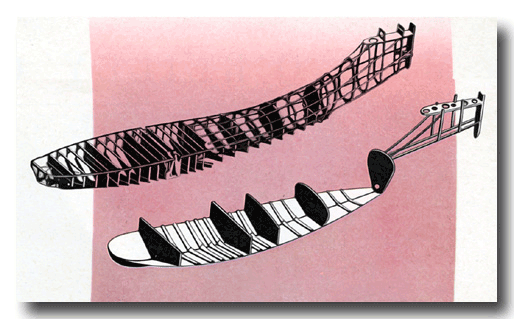
1. The hull: Far more difficult to build than a fuselage, the prototype Seabee hull required 362 parts, 590 man-hours, and 6,500 rivets. By putting most of the internal weight into a tough outer shell, Republic greatly increased strength and corrosion resistance. Eliminated: 20 pounds, 299 parts, 560 man-hours, and 4,100 rivets. Labor savings:
$1,400.
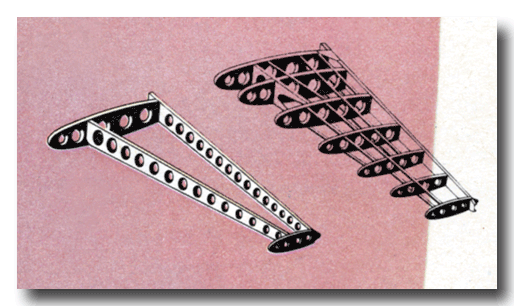
2. Stabilizers: Republic's search for simplification began with this assembly. All but one rib and two spars were dropped, their strength re-placed by a heavier skin with raised ridges four inches apart, like the wing skin at right. Savings: 32 parts,
11.5 man-hours, 361 rivets, and $28.75 in labor.
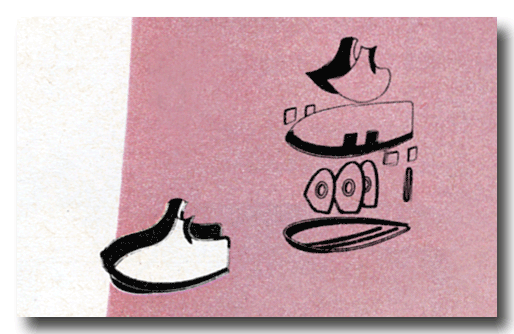
3. Wing-tip floats: Here a typical, twelve-part "egg-box" aircraft construction totally vanished,
leaving a two-part job whose deep-drawn halves are simply welded together, with a hit of
riveting around the neck. Fabrication time: 15 minutes. Saving: $23.
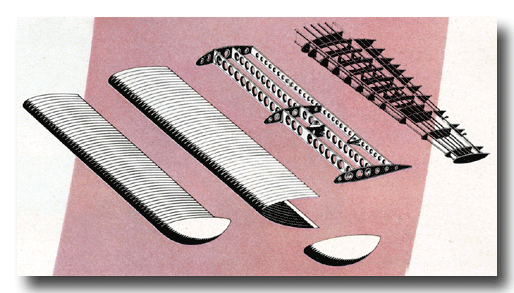
4. The wing: To prove to skeptics at Republic that the new stabilizer was no aerodynamic freak, the same principles were applied to the
wing panel, which is ten times as large. Note how the long-revered internal maze has melted into three ribs and three spars.
Over the simplified skeleton a single ribbed sheet is curled, riveted in one pass through Republic's new
machine,
and closed with a simple cap at the tip. Parts were reduced from 114 to 30, weight from 150 to
110 pounds, rivets from 2,627 to 882, and man-hours from 280 to
15. Labor savings: $662.
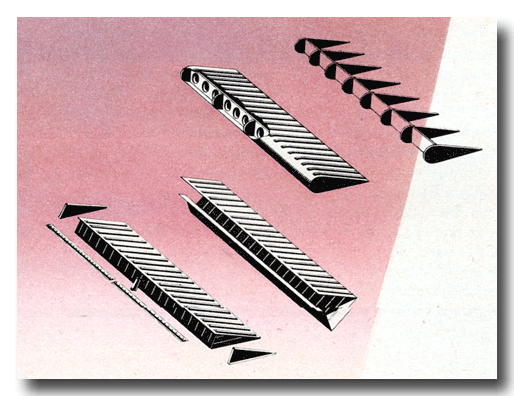
5. Ailerons: Republic's successful surgery had cut aileron parts from eighteen to eleven, there.
by saving $27 in man-hours. The completely hollow, six-part model shown below can be made in eighteen minutes and is
aerodynamically sound, but remained experimental
pending the solution of a hinging problem.
|
The Rainbow
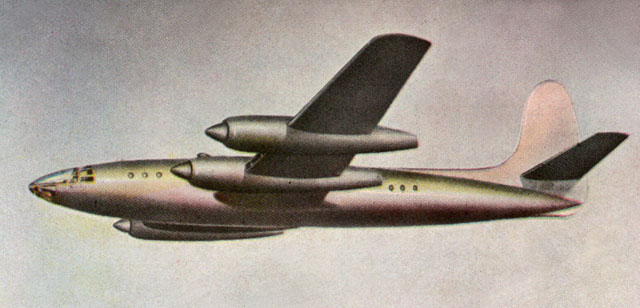
The sale of the commercial version of the XF-12
photo-reconnaissance plane that Republic is building for the Army is
anything but assured. Like the XF-12, which was flown a year ago,
the Rainbow transport is a triumph for Kartveli's streamlining genius; its
nacelles are so clean, for example, that they have only one-third the drag
of the usual transport design. And it is the Rainbow's top speed of
450 mph that is expected to sell it. Last year American Airlines
ordered twenty Rainbows, and Pan American six with an option of twelve
more. Although the Rainbow can carry only forty-six passengers -
much less than the capacity of the other big U.S. transports - both
airlines are counting on the prestige of the Rainbow's speed to draw the
luxury travel trade. Cruising at 400 mph, the Rainbow would be
approximately two hours faster between New York and London (nine hours)
than Boeing's forthcoming Stratocruiser, Lockheed's Constellation, or
Douglas' DC-6. On transcontinental U.S. flight the Rainbow might
save almost two hours, a fact that Pan Am, hopeful of securing CAB
franchises for such flights, has been loudly advertising. Republic
hopes to sell fifty Rainbows eventually. It is counting on the fact
that the transport's timesaving speed - which could mean a higher, more
profitable utilization rate - will persuade the airlines to buy.
Since the Rainbow has already won the admiration of both plane makers and
buyers, it is quite possible that other airlines might buy Rainbows to
meet the timetable competition of American and Pan Am. For Republic,
however, the Rainbow cannot be considered anything but a speculation - a
foot in the door of commercial aviation at a time when the demand is
shifting toward more and more speed. In the first place, there is
the fact that unless at least thirty-five of them are sold Republic will
not make a dime on their production. An in the second place, while
Republic's contracts were "firm", they were by no means
uncancelable. At any rate, a boom in Rainbow sales is hardly to be
expected until the airlines shake down their operating problems and
acquire more financial stamina than they have lately shown.
|
The Seabee
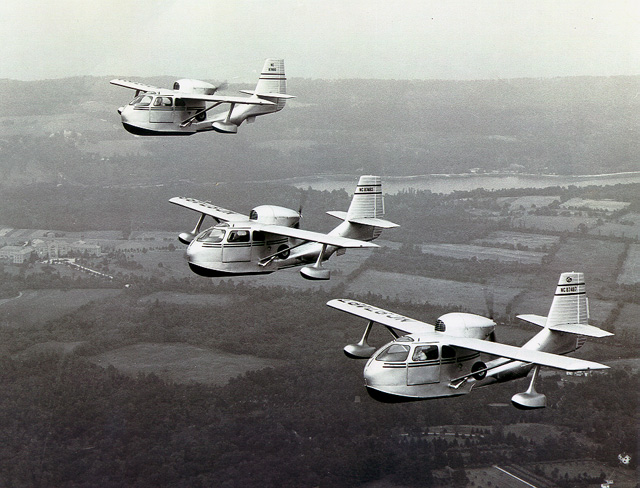
The decision to enter Republic in the competitive
small-plane market was largely Marchev's idea and his enthusiasm for such
a venture carried his Directors along with him in the autumn of
1943. The search for a small plane began with a spot check of US
aircraft dealers, which revealed the fact that Republic would have to put
out something pretty special since few dealers were interested in taking
on just another small plane. Marchev then was reminded of a small
wood-and-fabric amphibian that an ex test pilot, P. H. Spencer, had tried
to sell Republic back in 1941. Spencer's plane looked like a good
bet since there was no small, low-priced amphibian on the market. It
looked good enough to Republic's Directors for them to vote a $300,000
appropriation to develop an all-metal version of it that Republic might
produce. And, in passing, it can be reported that some of the
Directors hoped that the $300,000 appropriation would prove that going
ahead with actual production of such a vehicle would be impractical.
It was not until September, 1944, however, that
Marchev's enthusiastic faith in his little amphibian led him to believe
that enough of market existed to risk exploiting it with a mass-produced
plane. He admits arriving at this belief on the dubious strength of
a few published surveys, some dealer interviews, and his own
optimism. Then. after a small group of engineers was assigned to
start simplifying Spencer's model for mass-production, a research firm was
hired to survey the small-plane market for Republic. At the same
time Marchev worked out a sales formula of his own, using
Cadillac-car sales, income-tax returns (over $5,000), and U.S. population,
airport, and personal-plane statistics. According to the formula,
Republic could sell 2,500 small amphibians in the U.S. Marchev's
hopes for what was now called the "Seabee" soared that December
when thirty distributors at the National Aviation Trades Association
convention in St. Louis signed up to handle the amphibian and advanced $25
deposits on 1,800 orders. When the professional market survey
arrived showing only 1,500 possible Seabee customers, Marchev did not
believe it. On a St. Louis dealer survey he had already determined
to risk a production run of 2,500. And when orders for the Seabee
had mounted to more than 5,000 by middle of 1946, it looked very much as
if Marchev might prove his point about selling a mass-produced plane for
"under $4,000". He did not prove it, but at
any rate the Seabee project must be put down as a superb try.
Republic's production engineers had originally estimated that it would
cost $7,500 to produce the Seabee. But Marchev, who had originally
dreamed of a $2,500 price, stubbornly insisted that the Seabee could be
built for $3,500. Such a figure sounded impossible to many of
Republic's engineers. 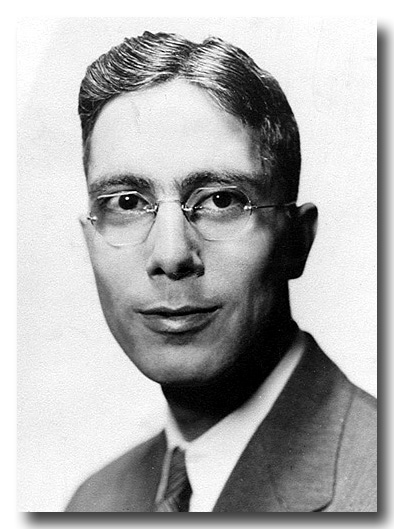 Nevertheless,
the Seabee experiment has since upset many concepts that are gospel to
aircraft engineers. The discoveries of Alfred Z. Boyajian, a crack
thirty-three-year-old Republic engineer, for example, have shown that the
complicated internal structure of aircraft wings and tail parts may be
entirely unnecessary. However skeptical his profession may be, the
fact is that Boyajian's simplification of the Seabee's airframe has
reduced the total number of parts from 1,800 to 450. What was eventually
accomplished on the Seabee's airframe is shown and more fully described in
the box above. Whether or not Republic succeeds in selling enough
Seabees to mass-produce them in fact, Republic's achievement represent a
major revolution in aircraft design. Nevertheless,
the Seabee experiment has since upset many concepts that are gospel to
aircraft engineers. The discoveries of Alfred Z. Boyajian, a crack
thirty-three-year-old Republic engineer, for example, have shown that the
complicated internal structure of aircraft wings and tail parts may be
entirely unnecessary. However skeptical his profession may be, the
fact is that Boyajian's simplification of the Seabee's airframe has
reduced the total number of parts from 1,800 to 450. What was eventually
accomplished on the Seabee's airframe is shown and more fully described in
the box above. Whether or not Republic succeeds in selling enough
Seabees to mass-produce them in fact, Republic's achievement represent a
major revolution in aircraft design.
The Seabee
experiment has also demonstrated two other Marchev convictions.
First, that enormous economies are possible by tooling up for aircraft
production, Detroit style, even without Detroit volume. With an
expenditure of $1,300,000 on tools, Republic expects to cut fabrication
time by 92 per cent - from 2,500 to 200 man-hours per Seabee. In
terms of time required, Seabee production might one day reach a figure of
twelve minutes per pound of airframe - or nearly half as low as the best
(twenty-one minutes) that Willow Run was able to achieve at the peak of
its B-24 output. And a second Marchev contention - that costs can be
slashed by buying parts without the aircraft label ("the license for
higher prices") - has been strikingly verified by Republic's use of
auto parts in the Seabee. Some sample economies achieved by this
policy are illustrated on page 126. Since buying low-cost
automotive-type parts and accessories has netted a saving of $1,000 per
Seabee, this policy has given other aircraft manufacturers something to
think about. On top of this, the Seabee experiment has
also given a few lessons to manufacturers of small aircraft engines.
When Republic went looking for a 200-hp engine in 1945, prices were around
$1,200 - or more than a third of what the Seabee itself was then scheduled
to cost. To get the price down, Republic felt it would have to get
the same kind of production economies in engine manufacture that it was
getting on the airframe, and the only way to effect them was by
controlling its own engine company. To that end it bought one of the
three major light-engine companies, Aircooled Motors, Inc., of Syracuse,
New York, one-time maker of the old Franklin engine. For the
$740,000 Republic advanced against future orders for engine research,
Aircooled has so altered and simplified its 215-hp engine that Republic is
now paying $800 instead of $1,200 for it. Aircooled hoped that
eventually it would get the price down to $600 and still more distantly to
$400. How many Seabees? Yet in
spite of what the Seabee experiment has thus far shown, it was an
extraordinary speculation for Republic to make. For one thing, it
was based on the premise that if the price of its Seabees were low enough,
thousands of would-be flyers would appear to buy it. It is a safe
little airplane, admittedly a lot of airplane for the money - even at
$6,000 - and it has no competition in its field. But it has limited
utility because of its low speed, and the market-through-low-price
assumption is something yet to be proved. Even if Republic had been
able to turn out a small plane of high quality for the originally
hoped-for price of $3,500, there is not much reason to believe that a mass
market for it would appear overnight. In 1935, of the 3,555 small
airplanes produced by U.S. aircraft makers, only 526 were in the $2,000 to
$10,000 price range. And that year less than 3,000 automobiles were
made to sell for more than $3,000. Last year the expansion of G.I. flying
schools, plus market demand that had been pent up for four years, drove
small-plane sales toward a total of 30,000, of which an estimated 90 per
cent were two-place aircraft selling for less than $3,500. But the
bloom is off, and private plane sales have skidded. Canceled orders
caused one company - Engineering & Research Corp., maker of the $3,450
spinproof Ercoupe - to stop production last November. Obviously,
there is currently a sharp limit to the market even for a $3,500 plane,
which might cost $1,500 a year in upkeep - a fact that darkens the whole
small-plane industry. By the middle of 1946, however, it
became evident that Republic was not going to be able to hold its Seabee
price down, In July, Republic got out a de luxe model, adding $500
to cover the addition of a reversible propeller and a cross-country
instrument panel. A $500 price increase on top of this was laid to
higher costs. Then, November 1946, the price was jumped another
$1,000, with the explanation that this was necessitated by rising material
costs, some eighty engineering changes, and "cumulative delay
costs" caused by non-delivery of tools and dies. Despite these
price rises, Republic's dealers still had 2,500 orders standing on their
books. But eighty engineering changes, some of which might easily
effect production economies, and "cumulative delays" could
hardly account for that last $1,000 increase. What could account for
it easily is a lowering of sights, a reduction in estimates of unit sales
- to 3,000, say, instead of 5,000 planes. And there are evidences
that such might be the case. Indeed, there was evidence that
Republic's whole postwar program, excepting, as always, Kartveli's
high-speed fighter, was dangerously behind schedule. The
crisis The trouble was one of Republic's old
troubles before the war - a thin cash position. During 1946 the
costs of the Seabee and Rainbow ventures, plus the acquisition of
Aircooled Motors, ate swiftly into Republic's $11-million wartime
profits. Then last fall, a $5-million preferred issue missed the big
bull market by a scant two weeks. The issue was postponed and
Republic went after a bank loan. Marchev, husbanding cash and
pressed by the coal embargo, laid off 3,200 of the company's 8,000
employees. After considerable negotiation Republic borrowed
$5,700,000 from New York's Chase Bank last December by hypothecating its
Thunderjet production payments. Considering Republic's condition,
securing this loan was a considerable feat for Republic's bouncing
President. Before the Chase Bank credit, Republic's working capital
had slipped from around $11 million to slightly under $4 million, and it
is clear that the company will be back in the market for equity money just
as soon as market conditions permit. It is also clear that the most
speculative of its postwar nonmilitary programs will be the first to
go out the window if the stock market continue to gyrate. This
crisis - and that is the only word for it - is the result of a brave
attempt to free the company from complete dependence upon military
contracts. At its worst the crisis can mean only that Marchev made
his bets on diversification too soon. Ironically enough, it is on
Kartveli's wall at Republic - and not Marchev's - that the wartime
aphorism appears; "Observe the turtle; he progresses only when his
neck is out". In putting out his neck, Kartveli has succeeded
usually in adding more speed to Republic's military aircraft. Mr.
Marchev, who is no turtle and glad of it, has taken risks that have yet to
pay off. As he very well knows, the aircraft business today is still
an engineering business. But someday, if it is ever to play an
important part in an expanding industrial economy, it must become a
business of production. When that day arrives, Mr. Marchev's
contributions may well be considered great.
|
Decision at Republic
This issue of FORTUNE had already come off the presses when the Directors of Republic Aviation Corp. suddenly made several very significant year-end decisions. Since these underscore the conflict and crisis that are described
in this article, they are appended herewith:
In effect, the Directors' decisions precipitated the most violent reorganization in Republic's
management since the company was formed in 1939. The upheaval was foreshadowed on December 28, when it was announced that Republic's chief engineer Alexander Kartveli had been elected a Director. Three days later, President Alfred Marchev was shifted to the board chairmanship, and his
forty year-old sales manager, Mundy I. Peale, was chosen to take over as President.
In the light of Republic's recent history these changes represent a drastic attempt to solve
Republic's basic trouble - a policy conflict involving management and the Board. Within three days after Peale took over, each of Republic's three production programs was reorganized and supervisory functions were
combined-even in Kartveli's department. As a result, four of the company's top management staff resigned, including Peale's recent superior,
Executive Vice President Hart Miller, whose prime job as general manager was assumed by Mr. Peale.
Republic's new President is neither an aircraft nor a production engineer but a salesman who has turned out to be a deliberate, diplomatic
administrator. As such, he can be counted on to safeguard Mr. Kartveli's interests at Republic. Peale came to Republic in 1939 after eight years with United
Aircraft
Corp.'s Sikorsky and Hamilton Propeller divisions. In 1940, Republic made him assistant director of military contracts, and at its wartime plant in
Evansville, Indiana, his administrative talents blossomed so 'spectacularly that Republic made him a Vice President in 1942 and a Director in 1944.
With the rise of Mr. Peale to the presidency, Republic has plainly resumed its role as an orthodox engineering aircraft manufacturer operating in the main on the design ideas of Director-engineer
Kartveli. In their present mood the Directors and new management of Republic are determined to carry on both the
Seabee and the military-plus-Rainbow programs. But it must be remembered that the
corporation is now in a period of flux following a
revolution in policy. This can mean that Mr. Marchev, even though he remains as Board Chairman, and the
Seabee program, even though Seabees are being manufactured, will have a relatively short life at Republic. It can mean that the
Seabee program has been kept alive simply because there is too much invested in it to iunk it. It can mean that sooner or later-and preferably sooner, for those
responsible for the company's new policy-Republic will seek to liquidate its investment of more than $4 million in the
Seabee, along with the $2 million or so it has tied up in the Aircooled small-engine plant. It could liquidate when it produces enough planes
And the most logical salesman for this Seabee package is, obviously, Mr. Marchev. Indeed, as an aviation executive his chief interest in aviation is in proving his contentions about mass-produced small aircraft. And since Republic's Directors are definitely not small-plane-minded and are also
considerably indebted to him-most recently for the $5-million loan he swung last
December - any bid their Chairman might find for the
Seabee project would receive serious and generous consideration.
___________________
"Fortune" Magazine
Article; "Experiment at Republic"
February 1947
|
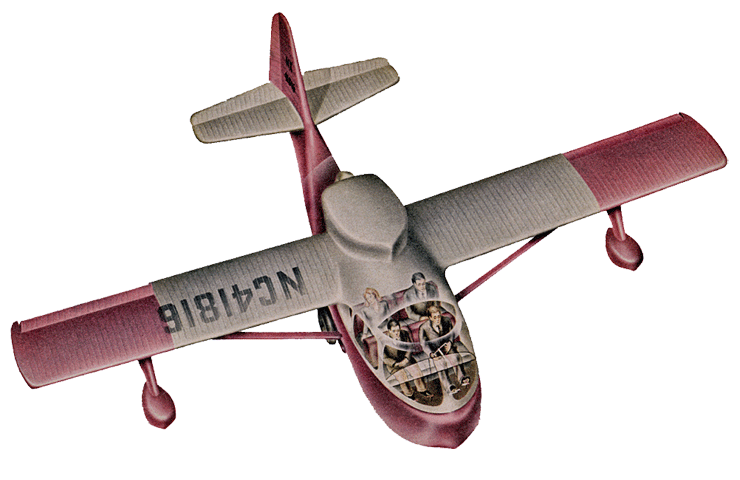
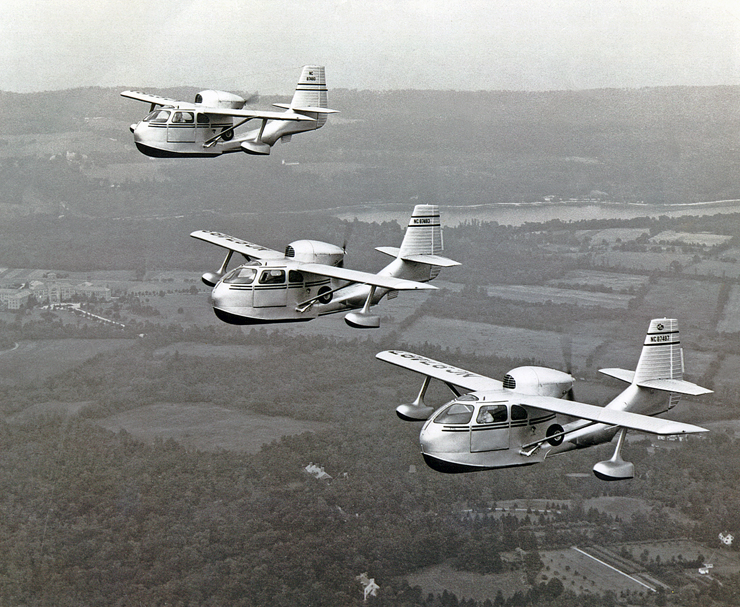
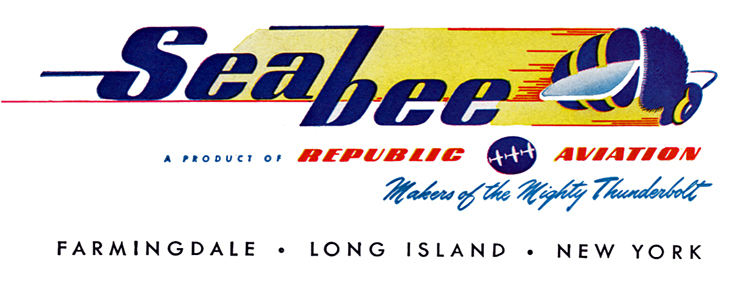
|






 Since military orders are Republic's bread and butter, it is not difficult to understand why chief engineer Alexander Kartveli is Republic's indispensable man. Kartveli's designing genius has made him the outstanding engineer in high-speed air-craft today. His worship of speed is intense, perfectionist, and uncompromising. In his office, for example, there hangs a
picture of Republic's P-47J-but he will not suffer the pain of looking at the final Thunderbolt model Republic eventually produced for the Army-the P-47N. For Kartveli the P-47N fell from grace when the Army insisted on installing a bubble cockpit canopy that violated the perfectly streamlined contours
of his earlier models. This temperamental Russian has remained the darling of the Army-he has successively designed the first
400-mph and the first 500-mph U.S.planes (both Thunder-bolt models), the 462-mph phcto-reconnaissance XF-12, and the P-84 Thunderjet, which last year in Army tests set the official
U.S. speed record at 611 mph. And before these planes Kartveli in 1939 designed the P-43, which was the first plane his former boss
Seversky succeeded in selling in any quantity to the Army. Kartveli, however, is a very expensive
sine qua non. Not because of his $30,000 salary but because his philosophy of high-speed aircraft design is something only the U.S. Air Forces can afford. That philosophy has committed Republic to making the fastest and most painstakingly clean aircraft Kartveli can devise-and to hell with the costs when national security is at stake. It means that Republic today has to have a swarm of 1.100 aeronautical engineers to
worry over the countless
complexities involved in building its racing fighters and transports. Designed for speed and range, equipped and built to customer specifications, the XF-12 and the Rainbow are as handmade as a house
by Frank Lloyd
Wright. The costs of this craftsmanship are enormous. Thus, while the Rainbow superficially appears to be the image of the XF-12 lengthened by a mere five feet, their differences are so complex and numerous that development and production costs for the first Rainbow will be $7,500,000-only 10 per cent less than what has already been spent to build one
XF-12. For the XF-12 the Air Forces pays the full cost price - plus a fixed fee, in this case $240,000 net. Republic's airline clients, however, will be doing exceptionally well if they can afford to pay $1,225,000 apiece for their Rainbows, with a possible profit of 10 per cent for Republic after the thirty-five break-even point has been reached. In the competitive private-aircraft market Kartveli's talents are obviously uneconomic. But those talents, having
produced $11 million in Thunderbolt profits in five war years, are
largely responsible for Republic's current $70-million backlog of military aircraft, which can easily turn into a $7 to $8-million
profit upon the completion of the contracts.
Since military orders are Republic's bread and butter, it is not difficult to understand why chief engineer Alexander Kartveli is Republic's indispensable man. Kartveli's designing genius has made him the outstanding engineer in high-speed air-craft today. His worship of speed is intense, perfectionist, and uncompromising. In his office, for example, there hangs a
picture of Republic's P-47J-but he will not suffer the pain of looking at the final Thunderbolt model Republic eventually produced for the Army-the P-47N. For Kartveli the P-47N fell from grace when the Army insisted on installing a bubble cockpit canopy that violated the perfectly streamlined contours
of his earlier models. This temperamental Russian has remained the darling of the Army-he has successively designed the first
400-mph and the first 500-mph U.S.planes (both Thunder-bolt models), the 462-mph phcto-reconnaissance XF-12, and the P-84 Thunderjet, which last year in Army tests set the official
U.S. speed record at 611 mph. And before these planes Kartveli in 1939 designed the P-43, which was the first plane his former boss
Seversky succeeded in selling in any quantity to the Army. Kartveli, however, is a very expensive
sine qua non. Not because of his $30,000 salary but because his philosophy of high-speed aircraft design is something only the U.S. Air Forces can afford. That philosophy has committed Republic to making the fastest and most painstakingly clean aircraft Kartveli can devise-and to hell with the costs when national security is at stake. It means that Republic today has to have a swarm of 1.100 aeronautical engineers to
worry over the countless
complexities involved in building its racing fighters and transports. Designed for speed and range, equipped and built to customer specifications, the XF-12 and the Rainbow are as handmade as a house
by Frank Lloyd
Wright. The costs of this craftsmanship are enormous. Thus, while the Rainbow superficially appears to be the image of the XF-12 lengthened by a mere five feet, their differences are so complex and numerous that development and production costs for the first Rainbow will be $7,500,000-only 10 per cent less than what has already been spent to build one
XF-12. For the XF-12 the Air Forces pays the full cost price - plus a fixed fee, in this case $240,000 net. Republic's airline clients, however, will be doing exceptionally well if they can afford to pay $1,225,000 apiece for their Rainbows, with a possible profit of 10 per cent for Republic after the thirty-five break-even point has been reached. In the competitive private-aircraft market Kartveli's talents are obviously uneconomic. But those talents, having
produced $11 million in Thunderbolt profits in five war years, are
largely responsible for Republic's current $70-million backlog of military aircraft, which can easily turn into a $7 to $8-million
profit upon the completion of the contracts. The other man in Republic's life is a tough-minded Swiss production enthusiast and salesman extraordinary, who is the
antithesis of Kartveli, the engineering perfectionist. President Marchev's
efficient, cost-conscious approach to aircraft manufacture is that of a crusading apostle of Detroit's production methods. Factually, of course, he is neither an automotive nor a peacetime aviation man. Nevertheless, during the war he did an excellent job of keeping Kartveli's Thunderbolt coming off the line. All day long he moves about Republic's shops and offices with the tireless bounce of a wrestler, checking this, re-checking that. In his zeal for following up the work of his subordinates he carries around a stack of three-by-five-inch slips on which he is constantly jotting down memoranda to be filed for later reference, or to be impaled on his desk pen as a current reminder. It is his energy
that charges Republic today. And his enthusiasm for production, matching Kartveli's love for design, was largely responsible for the fact that Republic during the war maintained one of the most consistently reliable performance records in the industry. The glory at Republic may go all to Kartveli, but Marchev's unorthodox ideas about mass-produced aircraft, as demonstrated in the
Seabee, have resulted in the most spectacular economies to be found anywhere in the
U.S. aircraft industry today.
The other man in Republic's life is a tough-minded Swiss production enthusiast and salesman extraordinary, who is the
antithesis of Kartveli, the engineering perfectionist. President Marchev's
efficient, cost-conscious approach to aircraft manufacture is that of a crusading apostle of Detroit's production methods. Factually, of course, he is neither an automotive nor a peacetime aviation man. Nevertheless, during the war he did an excellent job of keeping Kartveli's Thunderbolt coming off the line. All day long he moves about Republic's shops and offices with the tireless bounce of a wrestler, checking this, re-checking that. In his zeal for following up the work of his subordinates he carries around a stack of three-by-five-inch slips on which he is constantly jotting down memoranda to be filed for later reference, or to be impaled on his desk pen as a current reminder. It is his energy
that charges Republic today. And his enthusiasm for production, matching Kartveli's love for design, was largely responsible for the fact that Republic during the war maintained one of the most consistently reliable performance records in the industry. The glory at Republic may go all to Kartveli, but Marchev's unorthodox ideas about mass-produced aircraft, as demonstrated in the
Seabee, have resulted in the most spectacular economies to be found anywhere in the
U.S. aircraft industry today.






 Nevertheless,
the Seabee experiment has since upset many concepts that are gospel to
aircraft engineers. The discoveries of Alfred Z. Boyajian, a crack
thirty-three-year-old Republic engineer, for example, have shown that the
complicated internal structure of aircraft wings and tail parts may be
entirely unnecessary. However skeptical his profession may be, the
fact is that Boyajian's simplification of the Seabee's airframe has
reduced the total number of parts from 1,800 to 450. What was eventually
accomplished on the Seabee's airframe is shown and more fully described in
the box above. Whether or not Republic succeeds in selling enough
Seabees to mass-produce them in fact, Republic's achievement represent a
major revolution in aircraft design.
Nevertheless,
the Seabee experiment has since upset many concepts that are gospel to
aircraft engineers. The discoveries of Alfred Z. Boyajian, a crack
thirty-three-year-old Republic engineer, for example, have shown that the
complicated internal structure of aircraft wings and tail parts may be
entirely unnecessary. However skeptical his profession may be, the
fact is that Boyajian's simplification of the Seabee's airframe has
reduced the total number of parts from 1,800 to 450. What was eventually
accomplished on the Seabee's airframe is shown and more fully described in
the box above. Whether or not Republic succeeds in selling enough
Seabees to mass-produce them in fact, Republic's achievement represent a
major revolution in aircraft design.